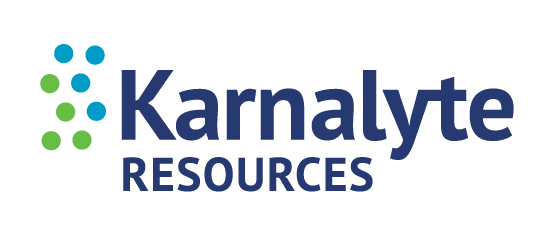In June 2016 Karnalyte Received an updated National Instrument 43-101 Technical Report for its Wynyard Potash Project “Technical Report Mineral Reserve and Resource Estimate for the Wynyard Carnallite Project, Subsurface Mineral Leases KL 246, KL 247 and KLSA 010, Saskatchewan, Canada KCl and MgCl2”. This report was prepared by ERCOSPLAN Ingenieurgesellschaft Geotechnik und Bergbau mbH, AMEC Foster Wheeler Canada, and Northrim Exploration Ltd., as third party experts with standing as Qualified Persons under NI 43-101 Regulations. It was issued on June 23, 2016 and filed on the Company’s profile at www.sedar.com.
The present Technical Report has been prepared by multiple authors: Principal Author is Dr. Henry Rauche EurGeol of ERCOSPLAN. Further authors are Dr. Sebastiaan N.G.C. van der Klauw, EurGeol of ERCOSPLAN, Ms. Lola Piché, P. Geo. of NREL, Mr. Ellis Buckner, P. Eng. of AmecFW. The authors are Qualified Persons as defined in NI 43-101 (the “Qualified Person”). Scientific and technical information referred herein has been extracted from and are hereby qualified by reference to the technical report for our project.
Download the Technical Report Here (20MB)
The Technical Report contains a comprehensive overview of Karnalyte’s property, geology, mining and recovery methods, required infrastructure, mineral resource and mineral reserves estimates, and all other aspects of the Project, with an effective date of June 23, 2016. The Technical Report includes separate analyses of both the potash and magnesium development opportunities (all figures in Canadian $):
Potash Project (Bankable Feasibility Study)
100% of production is 97% granular potash (KCL97TM) Phase one annual production of 625,000 tonnes, and all three phases 2.125 million tonnes.
- NPV (8% ) $3.39 Billion for all 3 phases (after tax)
- IRR 19.1% for 3 Phases, 2.125 million tpy project (after tax)
- CAPEX for Phase 1 $789 Million ($2.396 Billion for all 3 phases)
- OPEX for Phase 1 $136.99 per tonne ($131.70 for all 3 phases)
- Cost per installed tonne of Capacity $1,262 for Phase 1 ($1127 for all 3 phases)
- Proven & Probable Reserves of 147 million tonnes KCl
- Estimated Mine Life over 70 years for 3 Phases, 2.125 million tpy project
| Proven Reserves | Mineralized Material | Average KCl Grade % | Minable KCl Tonnage | Product Tonnage |
| Patience Lake + Belle Plaine | 268.6 | 18.7 | 50.3 | 46.6 |
| Esterhazy | 52.8 | 26.2 | 13.8 | 12.9 |
| Total Proven | 59.2 | |||
| Probable Reserves | Mineralized Material | Average KCl Grade % | Minable KCl Tonnage | Product Tonnage |
| Patience Lake + Belle Plaine | 425.1 | 18.6 | 78.9 | 73.2 |
| Esterhazy | 61.6 | 26.5 | 15.8 | 14.6 |
| Total Probable | 87.8 | |||
The discounted cash flow model to determine Net Present Value (NPV) and Internal Rate of Return (IRR) for the 2.125 million tpy Potash Project assume a commencement date for production in 2019 and a potash price of $466 (Canadian) per tonne based on a consensus price of potash market analysts with a 3% annual price increase.
Magnesium Project (Preliminary Feasibility Study)
Considers annual production of 100,000 tonnes of MgCl2 brine and 104,000 tonnes of 99+% Hydromagnesite (BMC). Construction assumed after phase 1 of potash)
- NPV (10%) $512 Million (after tax)
- IRR 26.1% (after tax)
- CAPEX (additional to Phase 1) $171 million
- OPEX for MgCl2 Brine $7.01 per tonne
- OPEX for Hydromagnesite $302.01 per tonne
- Probable Reserves for MgCl2 694.6 million tonnes of carnallitite @ 22.1% MgCl2, equivalent to 153.3 million tonnes “mineable” and 7.9 million tonnes of product
| Probable Reserves MgCl2 | Mineralized Material | Average MgCl2 Grade % | Minable MgCl2 Tonnage | Product Tonnage |
| Patience Lake + Belle Plaine | 694.6 | 22.1 | 153.3 | 7.9 |
| Total Probable | 7.9 | |||
The discounted cash flow model to determine Net Present Value (NPV) and Internal Rate of Return (IRR) for the Magnesium Project was determined based on prices of: $40 per tonne for MgCl2 brine, $600 per tonne for 50% of the Hydromagnesite as replacement for Precipitated Calcium Carbonate, and the remaining Hydromagnesite at $1800 per tonne as replacement for TiO2 in paint pigments.
In assessing the values of these projects the following key figures were determined using a discounted cash flow model:
- net present value (NPV): The NPV compares the present value of all cash inflows with the present value of all cash outflows. A positive NPV indicates that a project is expected to give a return in excess of the cost of capital; and
- internal rate of return (IRR): The IRR is the cost of capital or required rate of return which when used to discount the cash flows of a project produces a zero NPV.
The discounted cash flow model, including the metrics and methodology thereof (the “Model”) may not be directly comparable to Models used by other issuers. For further detail please refer to the Technical Report indicated above.
Karnalyte Technical Report
